 |
|||
Ulula Die 36-teilige italienische Fumetti-Serie Ulula erschien monatlich ab Oktober 1981 bis August/September 1984 bei Renzo Barbieris Label Edifumetto (das mit dem Hai-Logo). Dazu kamen ein Sammelband (1984) und zwei Supplements "I depravati di Manila” (1983) und "Buona carne in scatola” (1984). Die spanische Version brachte Ediciones Zinco in der Serie "Hembras Peligrosas" heraus. Ulla, nachts eine Wolfsfrau und tagsüber ein wunderschönes Fotomodell, ist vage angelehnt an Rino Di Silvestros italienischem B-Movie "La lupa mannara" von 1976. Die Idee für die Serie stammt von Giovanni Romanini, der auch die ersten vier Geschichten schrieb, bevor er die weiteren Drehbücher in die Hände von Stefano Berti, Renzo Barbieri und Giuseppe Pederiali übergab. Die optische Qualität der Serie wurde durch die hervorragende Zeichenkunst von Giovanni Romanini gewährleistet, der seinen Strich bei Fumetti Legende Roberto Raviola aka Magnus erlernte - was man der Serie auch ansieht. Charakter-Design und Seitenaufbau erinnern stark an Romaninis "Lehrmeister". An Romaninis Seite stand der junge William Bondi, der bereits an den Serien "Wallestein", "Pornostar" und "Bionika" mitwirken durfte. Die Titelbilder der Serie stammen vom Veteranen des Edifumetto-Stalls: Emanuele Taglietti. Die Werbung auf den Seiten der Edifumetto-Titel lautete: "Sie ist von unglaublichen Schönheit, von Beruf Model. In der Welt der Haute Couture konkurrieren die Fotografen um sie, alle Männer würden sie gerne ficken! Aber Ulula hat einen Makel... sie ist eine Wolfsfrau!" (1) In den ersten Ausgaben wird die Herkunft der "Wolfsfrau" in Rückblicken erklärt. Ulla ist unterwegs zu ihrem Onkel Graf Wilfred von Hagen, verunglückt jedoch mit ihrem Auto und verletzt sich dabei schwer. Sie wird in das Schloss ihres Onkels gebracht und dieser erkennt, dass nur eine Bluttransfusion sie retten kann. Um Ulla, die eine seltene Blutgruppe besitzt schnellstmöglich helfen zu können, benutzt Wilfred notgedrungen einen Wolf für die Bluttransfusion. Wie durch ein Wunder überlebt Ulla die Prozedur. Doch schnell wird klar, das diese Entscheidung keine gute Idee war. … Während ihr Onkel sich mit seiner Geliebten Ilona vergnügt, verwandelt Ulla sich zum ersten Mal in eine Wolfsfrau und greift sogleich die Mätresse ihres Onkels an. Wilfred wehrt seine Nichte mit einem Kerzenständer ab und schlägt sie bewusstlos. Ilona glaubt den beschwichtigenden Lügen des Barons nicht und will den Vorfall zur Anzeige bringen; verunglückt jedoch beim Versuch zu fliehen. Da Ulla wie ihr Onkel keine andere Möglichkeit sehen Ulla Geheimnis zu wahren, beschließen sie Ilona zu töten. Als der Graf eine Spritze vorbereitet um Ilonas Leben zu beenden erwacht diese aus ihrer Bewusstlosigkeit. Ulla unterbindet ihren erneuten Fluchtversuch und "verfüttert" Ilona kurzerhand an den Wolf, der ihr mit seinem Blut das Leben gerettet hat. Ulla verlangt von ihrem Onkel einen schnellen Erfolg mit einem Heilmittel für sie. Als dies nicht möglich ist, fasst Ulla den Plan das Schloss zu verlassen. Wilfred missfällt Ullas Vorhaben, beginnt jedoch sich in seine Nichte zu verlieben. Eines Nachts schleicht sich Wilfred in ihr Zimmer und vergewaltigte sie. Ulla wehrt sich, verwandelte sich in ihre Wolf-Persona und tötete ihren Onkel. Die Leiche wird an ihren Wolfsfreund verfüttert und Ulla verlässt das Schloss. Die Polizei hält den Tod des Grafen für einen Unfall und Ulla erbt die Besitztümer ihres Onkels. Das Werwolf-Model Ulla erlebt die unterschiedlichsten Abenteuer, die sie rund um die Welt führen und in denen sie sich unvorstellbaren Feinden stellt. In ihrer Eigenschaft als gefeiertes und bekanntes Modell, trifft sie in ihren spannenden Abenteuern auf höchst ungewöhnliche Gegner. Die Taschenbücher sind Produkte ihrer Zeit und die italienischen Fumetti waren berüchtigt nicht gerade zimperlich zu sein - bis hin zum gelegentlichen Tabubruch! So auch in den Abenteuern von "Ulula". Trotz der reichlichen Konkurrenz wie Zora, Lucifera, Sukia, Cimiteria, Isabella, Jolanda, Hessa, Walalla, Belzeba, Naga, Jacula, Yra, Wallestein,… konnte sich die kurzhaarige Ulla durchaus bei den Fans von Horror-Erotika behaupten. Der Charakter Ulla war so beliebt, dass etliche ihrer Abenteuer nachgedruckt wurden oder in Sammelausgaben gebündelt erschienen. Zudem war sie ein beliebter Gast in anderen Fumetti-Serien. Nachdrucke von "Ulula" Abenteuer erschienen unter anderem 1985 in der Edifumetto Serie "Super Poloziotta" und 1989 in der Serie "Fumetti Record", sowie 1993 in der "Serie Viola" bei Squalo Comics. Weiter hatte Ulula je zwei Auftritte in den Serien "Serie Star" (Edifumetto) ("Ulula: La Bambola del Male", "Ulula: La Lupa Mannara"), "Serie Nera", "Serie Extra" und "40 Gradi". (3) Im Jahr 2018 erschienen zwei neue Ulula-Bände bei Annexia Edizioni; geschrieben von Paolo Di Orazio und gezeichnet von Marco Turini. Die Titelbilder steuerte Altstar Emanuele Taglietti bei. 2022 wurde die Serie in Italien bei Editoriale Cosmo neu aufgelegt. Die spanischen Ausgaben bei Ediciones Zinco wurden leider (wieder einmal) nur zensiert veröffentlicht und die einzelnen Panels des italienischen Originals - mit dem Fumetti-Format 13 x 18 cm - in größere Seitenformate gepresst. Explizite Details wurden plump mit verdeckenden "Soundwörtern" "entschärft" (siehe Beispiele unten). Somit sind die spanischen Ausgaben von "Ulula" nicht zu empfehlen. Die Autorin Doris V. Sutherland hat in Ihrem Artikel "Ulula the Werewolf Woman" einige interessante Ansichten dargelegt: Doch früher war das ganz anders. In der britischen Literatur des neunzehnten Jahrhunderts war die bevorzugte Variante des Werwolfs eine schöne - sogar ätherische - Frau, die als Verführerin fungierte. Dieser Charaktertypus verdankt sich dem weit verbreiteten Märchenmotiv der Tierbraut, zu dessen Variationen Schwanenmädchen, Froschprinzessinnen und - ja - Wolfsfrauen gehören. … "Ulula" kommt vom italienischen ululare; ein Homonym für schreien/heulen eines Wolfes und schreien oder stöhnen beim Sex.
Quellen/Sources: |
Ulula The 36-part Italian Fumetti series was published monthly from October 1981 to August/September 1984 by Renzo Barbieri's Edifumetto label (the one with the shark logo). There was also an anthology (1984) and two supplements "I depravati di Manila" (1983) and "Buona carne in scatola" (1984). The Spanish version was published by Ediciones Zinco in the series "Hembras Peligrosas". Ulla, a wolf woman by night and a beautiful model by day, is vaguely inspired by Rino Di Silvestro's Italian B-movie "La lupa mannara" from 1976. The idea for the series came from Giovanni Romanini, who also wrote the first four stories before handing over the other scripts to Stefano Berti, Renzo Barbieri and Giuseppe Pederiali. The visual quality of the series was ensured by the outstanding draughtsmanship of Giovanni Romanini, who learnt his art from Fumetti legend Roberto Raviola aka Magnus - and this is evident in the series. The character design and page layout are strongly "inspired" by Romanini's "teacher". Romanini was assisted by the young William Bondi, who had already worked on the series "Wallestein", "Pornostar" and "Bionika". The covers of the series were created by the veteran of the Edifumetto stable: Emanuele Taglietti. The advert on the pages of the Edifumetto titles read: "She is incredibly beautiful, a model by profession. In the world of haute couture, photographers compete for her, all men would like to fuck her! But Ulula has a flaw... she is a wolf woman!" (1) In the first issues, the origin of the "wolf woman" is explained in flashbacks. Ulla is on her way to visit her uncle Count Wilfred von Hagen, but has an accident with her car and injures herself badly. She is taken to her uncle's castle and he realises that only a blood transfusion can save her. In order to help Ulla, who has a rare blood type, as quickly as possible, Wilfred is forced to use a wolf for the blood transfusion. Ulla miraculously survives the procedure. But it soon becomes clear that this decision was not a good idea. ... While her uncle is enjoying himself with his lover Ilona, Ulla transforms into a wolf woman for the first time and immediately attacks her uncle's mistress. Wilfred fends off his niece with a candlestick and knocks her unconscious. Ilona does not believe the baron's reassuring lies and wants to report the incident to the police, but has an accident while trying to escape. As Ulla and her uncle see no other way of keeping Ulla's secret, they decide to kill Ilona. When the Count prepares an injection to end Ilona's life, she awakens from her unconsciousness. Ulla stops her renewed attempt to escape and "feeds" Ilona to the wolf who saved her life with his blood. Ulla demands that her uncle find a cure for her quickly. When this is not possible, Ulla decides to leave the castle. Wilfred dislikes Ulla's plan, but begins to fall in love with his niece. One night, Wilfred sneaks into her room and rapes her. Ulla fights back, transforms into her wolf persona and kills her uncle. The body is fed to her wolf friend and Ulla leaves the castle. The police believe the count's death was an accident and Ulla inherits her uncle's possessions. The werewolf model Ulla experiences a wide variety of adventures that take her around the world and in which she faces unimaginable enemies. In her role as a celebrated and well-known model, she encounters highly unusual opponents in her gripping adventures. The paperbacks are products of their time and the Italian fumetti were notorious for not being squeamish - even to the point of occasionally breaking taboos! This was also the case in the adventures of "Ulula". Despite plenty of competition such as Zora, Lucifera, Sukia, Cimiteria, Isabella, Jolanda, Hessa, Walalla, Belzeba, Naga, Jacula, Yra, Wallestein,... the short-haired Ulla was able to hold her own with fans of horror erotica. The character Ulla was so popular that many of her adventures were reprinted or bundled together in collected editions. She was also a popular guest in other Fumetti series. Reprints of Ulula's adventures appeared in the Edifumetto series "Super Poloziotta" in 1985 and in the "Fumetti Record" series in 1989, as well as in the "Viola Series" published by Squalo Comics in 1993. Ulula also made two appearances in the series "Serie Star" (Edifumetto) ("Ulula: La Bambola del Male", "Ulula: La Lupa Mannara"), "Serie Nera", "Serie Extra" and "40 Gradi". (3) In 2018, two new "Ulula" volumes were published by Annexia Edizioni; written by Paolo Di Orazio and drawn by Marco Turini. Former star Emanuele Taglietti contributed the covers. In 2022, the series was republished in Italy by Editoriale Cosmo. The Spanish editions by Ediciones Zinco were published unfortunately (again) only censored and the individual panels of the Italian original - with the Fumetti format of 13 x 18 cm - were pressed into larger page formats. Explicit details were clumsily "toned down" with masking "sound words" (see examples below). The Spanish editions of "Ulula" are therefore not recommended. The author Doris V. Sutherland has put forward some interesting views in her article "Ulula the Werewolf Woman": But things were very different in the past. In nineteenth-century British literature, the favoured variation of the werewolf was a beautiful - even ethereal - woman who acted as a seductress. This character type owes much to the widespread fairytale motif of the animal bride, variations of which include swan maidens, frog princesses and - yes - wolf women. ... ...Is Ulula a contemptible piece of exploitation, a harmless piece of derivative nonsense or an amusingly cheeky pulp adventure? Could one even argue that it is - at least in some respects - a progressive work, thanks to the portrayal of gays and the reversal of the male gaze?" (4) "Ulula" comes from the Italian ululare and means wolf howl, but can also mean scream or moan; a combination of screaming/howling of a wolf and screaming during sex. |
||||||||
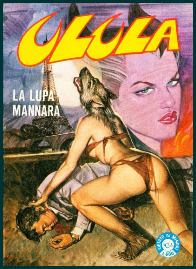 |
|||||||||
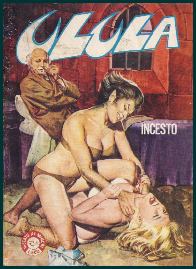 |
|||||||||
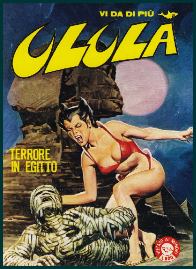 |
|||||||||
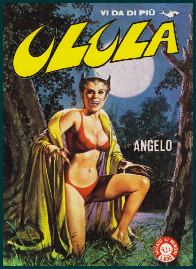 |
|||||||||
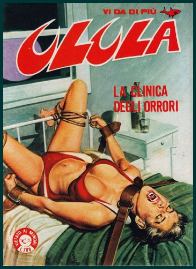 |
|||||||||
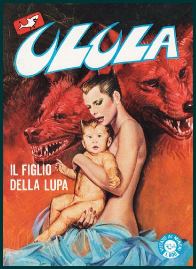 |
|||||||||
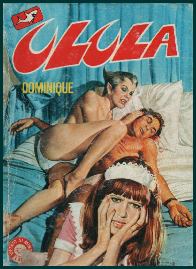 |
|||||||||
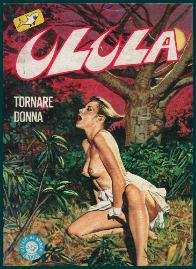 |
|||||||||
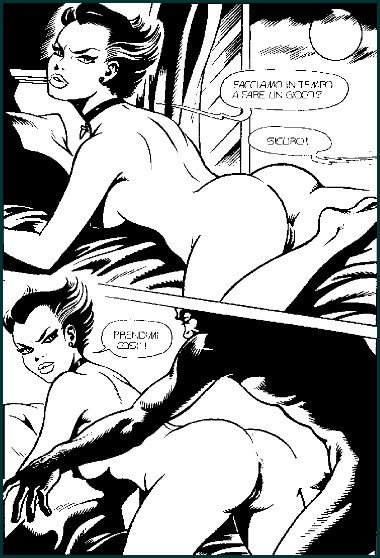 |
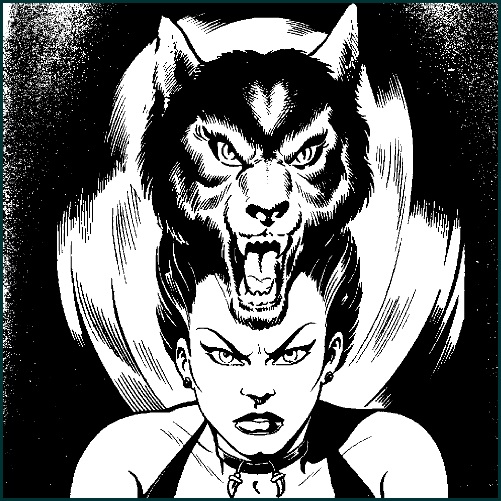 |
|||
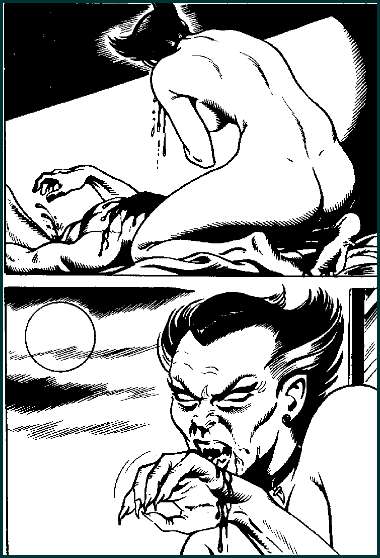 |
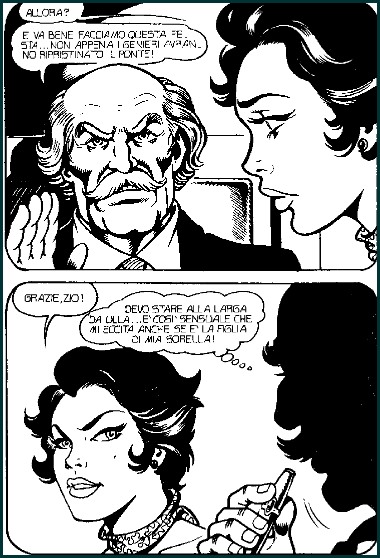 |
|||
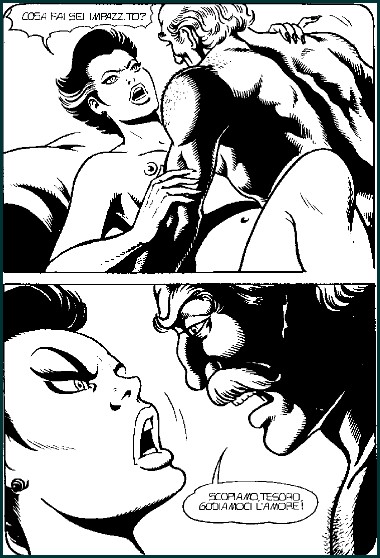 |
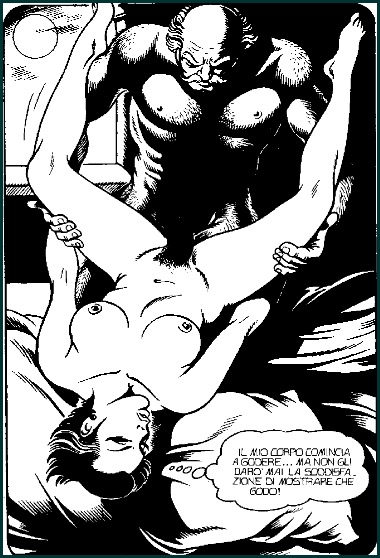 |
|||
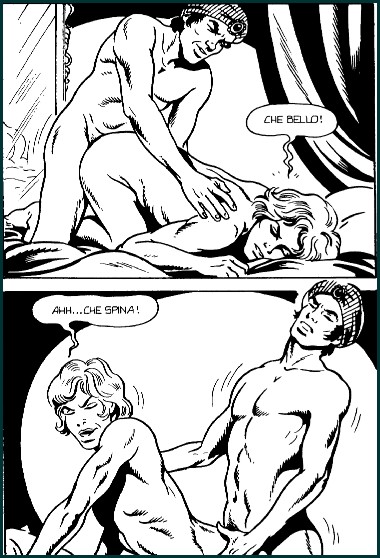 |
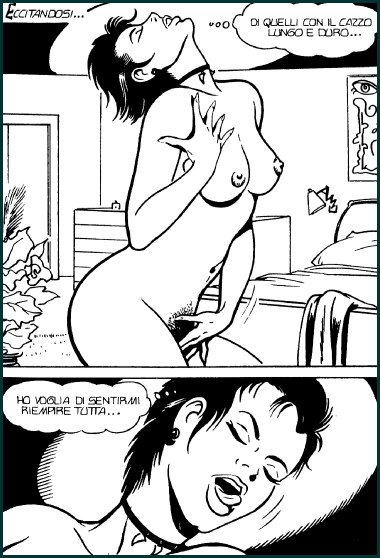 |
|||
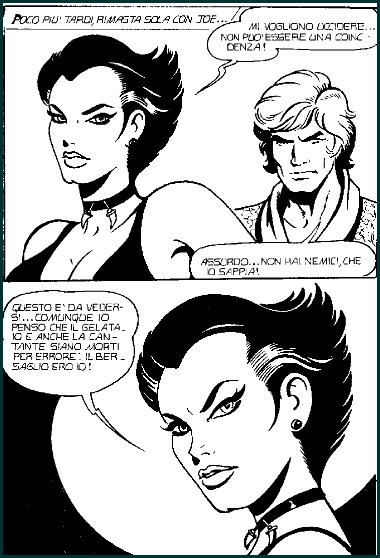 |
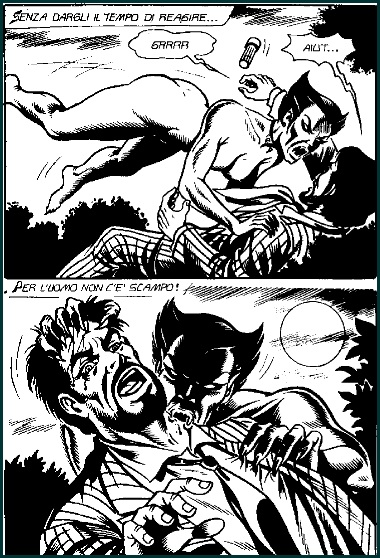 |
|||
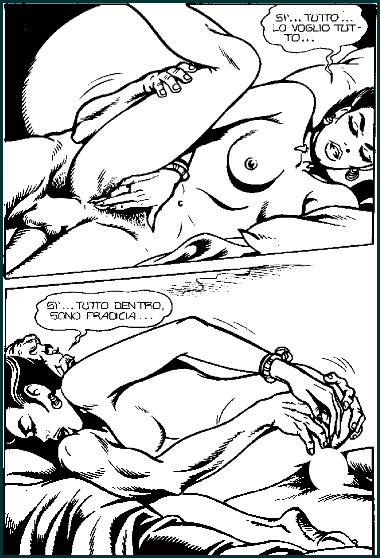 |
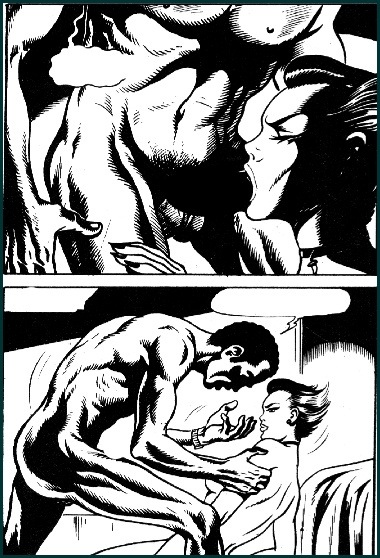 |
|||
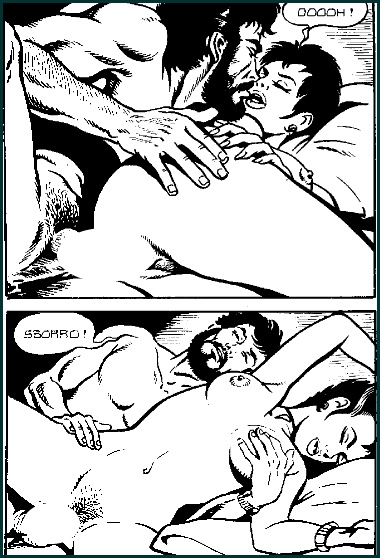 |
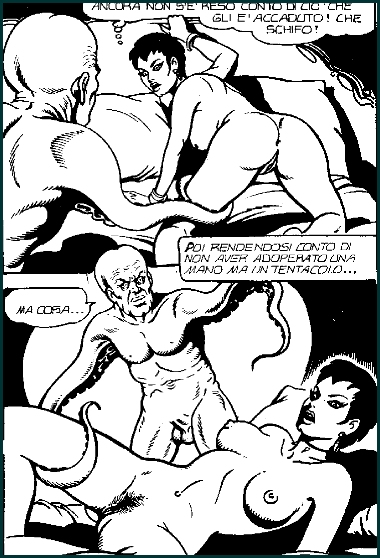 |
|||
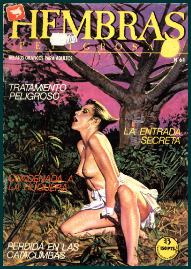 |
|||||
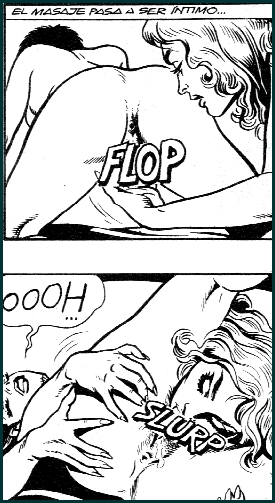 |
|||||
 |
|||||